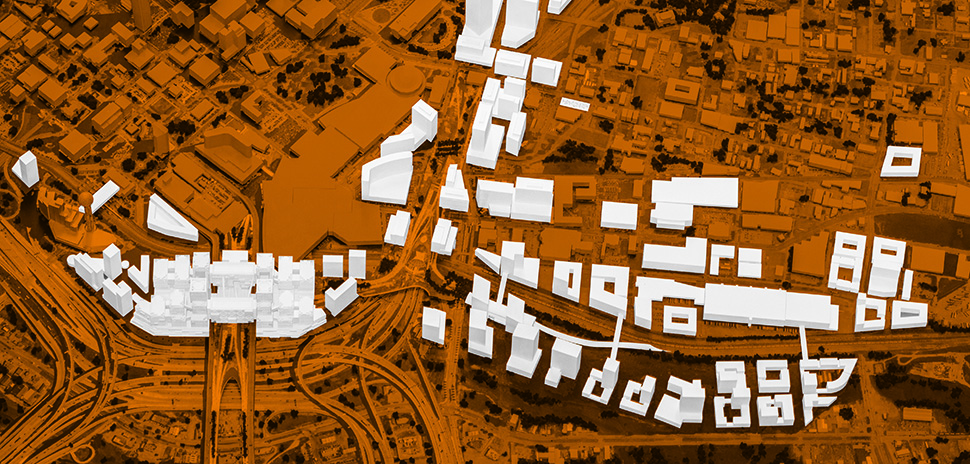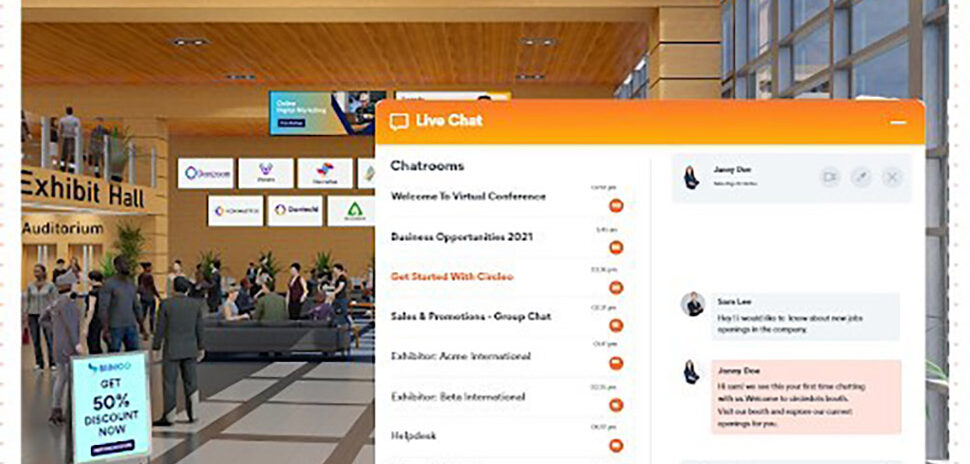This article was originally published in the Spring 2019 edition of the Dallas-Fort Worth Real Estate Review. The transcript has been edited for brevity and clarity.
It was the decision that had city leaders across the nation on the edges of their seats for most of 2018: Who would win Amazon’s HQ2? Three insiders look back on how it went and what’s next in a panel moderated by D CEO Editor Christine Perez. The takeaways have the three experts looking to the future.
Amazon made two official visits to DFW, and the unified front presented in the region’s overall response to the largest RFP in Dallas-Fort Worth history was noticed. Dallas “checked all the boxes” for what Amazon was looking for and was a finalist in the search. While in the end, Amazon chose Crystal City, Virginia—after an initial announcement in November 2018 to split its second headquarters between Crystal City and Long Island, New York—we gained a road map for how to develop downtown Dallas’ urban center.
And we’re ready for other interested companies with many other sites around the region, according to the Dallas Regional Chamber, who led the coordinated efforts for the pitch. The tale of the pitch is a two-part story: The initial regional response, a massive effort coordinating 55 sites across 22 communities, and the second stage, a detailed City of Dallas bid once Amazon made its decision to focus on the Dallas core.
A panel discussion featuring prominent Dallas leaders who talked about their roles in the roller-coaster race for HQ2—Mike Rosa, senior vice president at the Dallas Regional Chamber, Linda McMahon, president and CEO of The Real Estate Council, and Todd Watson, senior vice president at Hunt Realty, was held earlier this year, hosted by the Urban Land Institute North Texas.
It’s a forward-looking group. And, as Rosa said, “We never hung up the phone with Amazon.”
Here’s what the insiders have to say about the experience.
Meet the Experts
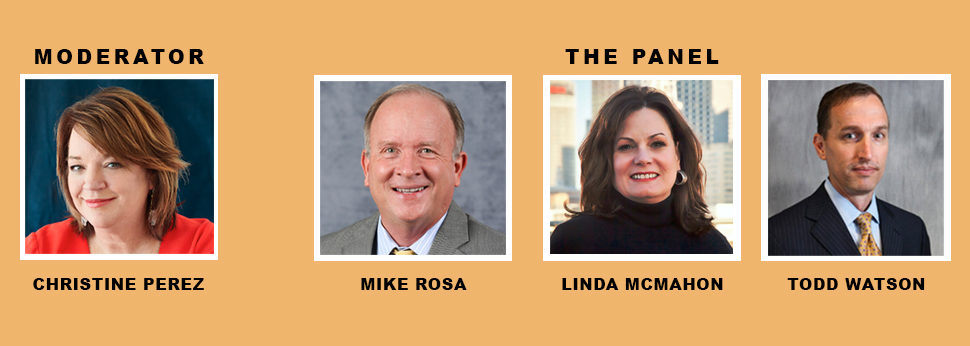
M O D E R A T O R
Christine Perez
Editor, D CEO Magazine
P A N E L
Mike Rosa
Senior Vice President of Economic Development, Dallas Regional Chamber
Linda McMahon
President and CEO, The Real Estate Council
Todd Watson
Senior Vice President, Hunt Realty Investments
CHRISTINE PEREZ: We’re here to talk about the remarkable battle for the Amazon HQ2. What were your initial reactions when you heard the news and your thoughts about Dallas-Fort Worth’s chances?
MIKE ROSA: On the morning of Sept. 7, I was speaking on a panel in Irving with Brandom Gengelbach from the Fort Worth Chamber when both of our phones started blowing up around 7:30 a.m. We looked at each other: It was hard to concentrate on panel remarks after that, I’ll guarantee you. Briefly, after the breakfast, we talked about it, and I went back to the office to respond to Amazon’s invitation that essentially said, “If you’re interested, email this address.” I immediately got a confirmation that said, “Great, we got you on record, you’re going to respond. And, you will coordinate the response.” It was quite clear, from the very beginning, Amazon wanted one response—a single response from any interested metro area in North America of more than a million people.
The RFP questions were very, very simple. It was a one-page request for information, and there were nine questions. There were really seven different topics, with a couple of the questions around incentives.
Because of the way we’re built as a region with a major city to the west, as well as major suburban cities, the Dallas Regional Chamber (DRC) has established an architecture to respond to these [kinds of] requests over the years.
Amazon ended up getting 238 bids—three times more than they really asked for, based on its initial ask of one response per metro that qualified on populations. There are only 75 [of those qualifying metros] in North America. For this region to come together with one bid was remarkable, and it made a great impression on them.
“Amazon ended up getting 238 bids—three times more than they really asked for, based on its initial ask of one response per metro that qualified on populations. There are only 75 [of those qualifying metros] in North America. For this region to come together with one bid was remarkable, and it made a great impression on them.”
—MIKE ROSA
LINDA MCMAHON: When I heard the news, I said, “This is a no brainer. I thought Dallas-Fort Worth was the obvious choice. We’re the best place to be in the country. We have the most available opportunities for an organization like Amazon to relocate to.”
And, coincidentally, about four months before that announcement, I’d gone to Seattle for a long weekend. I walked all around their campus on South Union and soaked in what the feel was in the neighborhoods that Amazon had chosen to be in. It’s not a typical corporate campus. When I got a phone call from the mayor’s office asking The Real Estate Council to be involved, I was super excited. My role was to represent the City of Dallas in the regional bid.
TODD WATSON: Hunt Realty had two sites that we submitted on the initial RFP: 11 acres in Uptown between the Perot Museum and the American Airlines Center that was part of a Victory/Uptown aggregated submission. We also submitted our Reunion site, along with a city of Dallas land parcel, and the former Belo headquarters. Obviously, we thought Dallas was going to show well, and we had some good sites and prospects.
We’ve heard a lot about the team effort and how everyone mobilized to help give Dallas its best shot at winning the big prize. It seems like this was a game changer in how massive relocations are typically pursued. How did it all come together and what were your individual roles in the process?
ROSA: After Amazon’s announcement on Sept. 7, there was a lot of excitement and buzz around that. But we had a race with time: The responses were due in early-to-mid October. With only about six weeks to put the bids together, we had to build a timeline quickly. That might be simple for one city to do, but for the region—with all of the powerful communities, the great leaders, the great sites that we have, and all the things that needed to go into it—we had to split that timeline. It was for the customer—for Amazon—and it had to make sense. It wasn’t a matter of taking each community’s package, punching three holes, and putting them all together in a giant binder to send off to the company. That wouldn’t help Amazon understand our region. In the back half of the six-week timeframe, we—the DRC, along with Boston Consulting Group, Linda, and others—had to synthesize it all to make it digestible for Amazon in our unified response to the RFP. We worked backwards from the time it was due and put a tremendously compressed deadline on the communities that were participating. We also routed the various real estate interests through the host cities. That was an important part of the initial strategy. The host cities needed to make decisions within their communities as to which sites they wanted to submit. It wasn’t going to work well if all the real estate interests bypassed the host cities to come directly to the Dallas Regional Chamber. In the end, we had a linear process that worked pretty well—despite the headaches, the crunches, the late nights, and the weekends.
And it was all required: We had to make sure that Amazon could understand this region. We had different sites and different communities offering different things. We built a regional response that helped Amazon digest it all. We used websites, spreadsheets, and other things that would make it very, very easy for them to understand all the communities and sites that were in place.
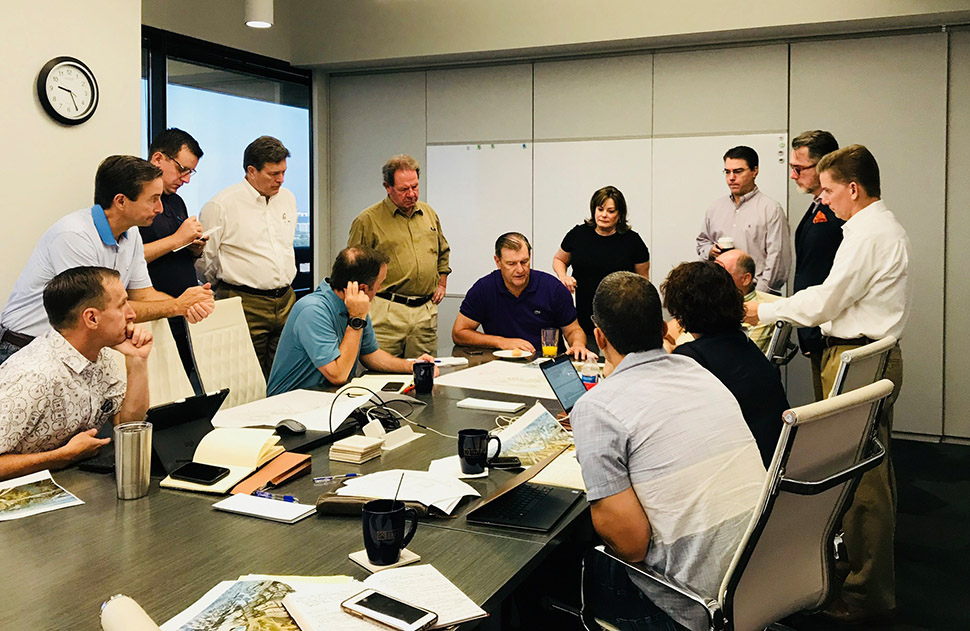
War room: Mayor Mike Rawlings, Linda McMahon, and a team of developers met at TREC on Saturdays to hammer out the vision they wanted to create for the City of Dallas during the second phase of the bid process. [Photo: Courtesy The Real Estate Council]
The DRC made a promise to all the communities. And it’s because of that promise we made that the public hasn’t seen the regional bid released. While the communities could talk about their individual bids, the DRC promised that, in working through us, we would not reveal the information—even if they did. Certainly, we would not reveal the sites that were submitted or disclose the incentives that were offered. That promise was important to the communities.
Compliments really go to all the communities that submitted. They were compiling all the real estate interests under tremendous pressure, because we had have the information back in enough time to package it in one unified regional bid for Amazon.
MCMAHON: My role in the process was to be on the team that the Dallas Regional Chamber put together, which was a combination of consulting groups and other representatives. The Fort Worth Chamber of Commerce economic development EVP was at the table along with Dallas Regional Chamber.
The team became all about Amazon. We absorbed everything about Amazon. We read everything we could read. We asked, “What does ‘Day One’ look like?” All of us talked to sources who worked with, or at, Amazon. We discussed what it was like when they built out their campus in Seattle, asking, “What were they looking for? What do you think that they want to hear about when they come to Dallas?” It was enlightening. We had several different people who had worked either at Amazon or with Amazon at a very high level. We wanted to kind of get into the heads of what it was that Jeff Bezos would want. We all talked about his six page memo a lot. It was an interesting process for all of us because it made us realize how differently they operate, and how they think versus the way a lot of other corporations do.
While Dallas is famous for having great competition in the real estate industry—and we do have some of the greatest companies in the country and in the real estate development world here—everyone worked together … But our real estate development companies all had one mission: How are we going to get this business? It was an interesting process to work with all the various companies and all the various interests, but all with one goal in mind.
“The team became all about Amazon. We absorbed everything about Amazon. We read everything we could read. We asked, “What does ‘Day One’ look like?” All of us talked to sources who worked with, or at, Amazon. We discussed what it was like when they built out their campus in Seattle, asking, “What were they looking for? What do you think that they want to hear about when they come to Dallas?” It was enlightening.”
—LINDA MCMAHON
WATSON: I’ll echo that. We reached out to all of our counterparts in downtown Dallas. We were talking to them as part of our submission. We worked with Hillwood and the Victory submission package. From our perspective, we had participated in contests like this before, but not of this magnitude. We needed to elevate our game to a tremendously different level. We enlisted HKS’ Brian Trubey for the first-round submission, which was a high-level real estate overview, [rather than an] in-depth analysis of specific sites. We had about three weeks, max, on our side to submit. The DRC would then have additional time for compiling the information.
MCMAHON: I honestly think Amazon would not have picked the City of Dallas without the presentation HKS put together. The first call I made when the Mayor contacted me was to Mark Buskuhl at HKS—they were essential in the project, working pretty much as a pro bono effort for the City of Dallas.
We had a “war room” where all of the City of Dallas bid planning took place at HKS. We worked side by side with the graphics team and their designers lead by Craig Kolstad and Brian Trubey, who is a great visionary. HKS went to great lengths to ensure that the City of Dallas bid was the best.
There were two visits by Amazon. What was on the itineraries? What were the hot buttons for Amazon and what were their reactions?
ROSA: Amazon announced 20 finalists in January 2018. A couple of days after the announcement, I got on the phone with them and learned what they wanted to see. We got word at the end of January that they were coming here Feb. 11-13. They wanted to see certain sites, which meant visiting with certain communities. That part of it was sort of “preset” by them.
We would have two days [with Amazon]. With all the data we had shared with them, they already knew that we have outstanding air service. They knew that we have two great airports and flights to everywhere. We check the box—over and over again—on air service. We gave Amazon credit for knowing what our strengths were.
Let’s not forget that they’re already here in the region. They’ve got thousands of employees here. They’ve got an engineering center near the Galleria with 500 engineers. And they’ve got fulfillment centers and distribution center operations.
They know how much we make, they know what we buy, and they know where we live. So, they already had a lot of information about this region, and we didn’t need to [repeat] the basics in those two days.
We focused on the things we wanted them to know. We wanted to focus on the variables where Amazon might not fully understand the region and on what some of the mis-perceptions might be.
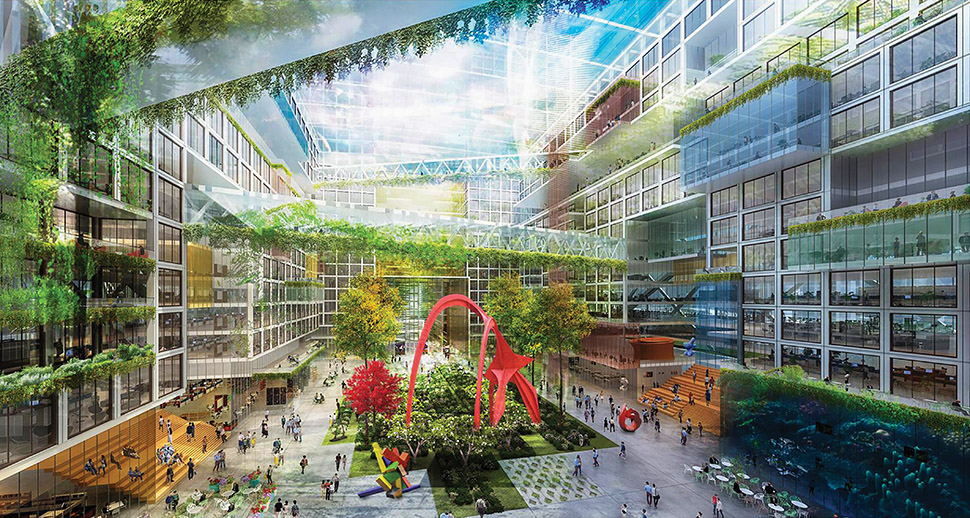
The bio cube: At the center of the proposed campus was a bio-centric hub to be used as gathering and event space for occupants and visitors. [Rendering: HKS]
And we considered the speculation in the articles we were reading in the media—Amazon this and Amazon that. We noted all the opinions they were getting—things like, “Don’t go to Texas because the LGTBQ community protections aren’t maximized.” We wanted to focus on diversity, education, transit, transportation, and ground transportation. We looked at the stories in the Wall Street Journal, USA Today, and others on where Amazon might go and where they were likely to pick.
So, in addition to visiting the sites and the communities representing those sites [with Amazon], we focused on those softer issues. We wanted to bolster Amazon’s knowledge of the region—not wanting them to leave here with any doubts that we’re strong—and as we said at the very beginning, that we check all the boxes.
Amazon visited all 20 of the finalist locations, so they did a lot of work, too. I can’t imagine making 20 trips within the span of three months.
MCMAHON: To Mike’s point about the softer things: Amazon is a dog-friendly company. So we had a lot of emphasis on how many dogs are in our community. We drove by dog parks. We wanted to make sure that they understood we love dogs as much as they love dogs. So, yes, it was all of those softer things.
But, we also wanted to emphasize that, particularly with the coming of high-speed rail, we will be at the center of the largest economy in the world connecting Houston and Dallas. That’s something that we can’t underestimate the power of.
We’re also on the edge of emerging technology. We’re one of the only places in the U.S. for Uber Elevate. The region is just now starting to get recognition for these kinds of things on an international basis, so it was something we had to present to them. We’re a forward-looking community, we’re a forward-looking region, and we’re there for the future.
We’re not an old economy: We’re a new economy. That’s something we wanted to help them understand. We’re a fairly new city [relative] to the other cities that they were looking at. We’re forward looking, and we’re not caught up in our ways. We have the ability to [welcome] them and have them not be, “This is Amazon town.” That’s their problem in Seattle. Dallas has such a diverse economy that we could easily integrate them into the fabric of the city if Amazon came here with 50,000 employees, in addition to the immigration of 50,000 people every single year—so we couldn’t become “Amazon town.” They did not want that.
“But, we also wanted to emphasize that, particularly with the coming of high-speed rail, we will be at the center of the largest economy in the world connecting Houston and Dallas. That’s something that we can’t underestimate the power of.”
—LINDA MCMAHON
WATSON: On that first tour, how many sites did they see?
ROSA: On the first follow-up phone call, they shared six sites that they were most interested in. Before they came, they eliminated one that they shared with us. When they visited the first cities and regions of the 20, we were maybe third or fourth on the list.
They realized that urban was probably what they were looking for. You may recall that the original RFP invited suburban greenfield sites. Our communities responded to that by offering exactly what they said they were interested in, but we knew that they were leaning toward urban by the time they got here. They ended up with five sites in three communities when they came in on that first visit on Feb. 13, 2018. You all know what it’s like to coordinate, drive around, and visit multiple sites—we didn’t have much time to waste. We had to work in all the meetings around those site visits.
WATSON: Hunt Realty was one of the five sites—the Reunion site. I think Chris Kleinert had 20 minutes with Amazon. Fortunately, we had a nice vantage point—Reunion Tower—to overlook our property and the city’s property. But again, we had 20 minutes to show our wares. I think we all walked away from the presentation—or Chris did that day, along with Mike and Linda—saying, “Hey, Dallas showed well.”
Right after that tour, we got a request for information, and that’s when we dug into details. The RFI was probably 10 to 20 pages of information that they were requesting, including property level surveys, property level diligence, infrastructure, fiber, transit, and more for specific sites. We took our planning to the next level with HKS and engaged for another six to eight weeks of detailed planning that yielded results for us when they came back around for their second tour last August.
MCMAHON: One thing that made the City of Dallas bid very unique was the concept that we presented to them—a place-based vision. It wasn’t just a real estate site. We combined all of the different sites into a sense of place. So, ultimately, they wanted to look at Reunion Place.
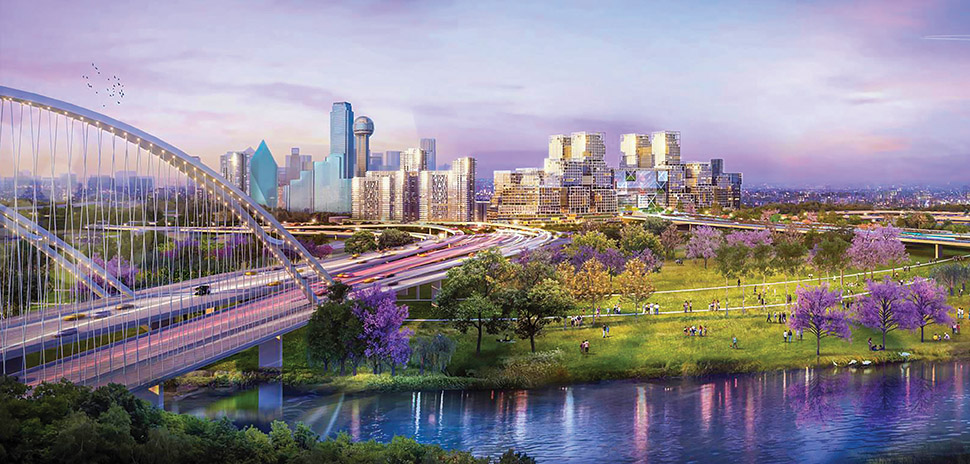
Proposed as the new gateway to the Central Business District, Amazon HQ2 at Reunion would have become the primary impression on the skyline of Southwest Downtown. [Rendering: HKS]
We were trying to give them the sense of community. We may have had four or five different real estate sites with four or five different real estate developer owners. But we had a sense of place. Robin Bentley, [assistant director of the Office of Economic Development for the City of Dallas], and Raquel Favela, [former chief of Economic Development & Neighborhood Services for the City of Dallas], are really responsible for coming up with that concept.
Ed. note: Favela is currently director of the National Development Council.
ROSA: After the last meeting on Feb. 13, we took them back to the airport in a bus. It was a chance to lean over the seat and talk directly with Holly Sullivan, Amazon’s lead project coordinator. We didn’t ask her, but she talked about the quality of the people that they met. She complimented us on the organization of the trip. We got a lot done in a short period of time.
Amazon left that first tour with a very, very positive impression. We could tell from the depth of the questioning, the time they invested here, and the interactions that they had. If it wasn’t real, they should all get the Academy Award for Best Actor and Actress. And that impression carried through when they came back in August 2018.
That second visit—the super-secret visit—was Aug. 9, 2018. It was preceded by a very, very detailed RFP: one that hasn’t been talked about much compared to the initial RFP. That initial one page RFP with nine questions was nothing compared to the detailed RFP of about 250 questions. That second RFP was more like a traditional RFP we might receive from a corporate location opportunity that we typically work on in secret. That RFP led to a great visit that August.
There were two visits by Amazon. What was on the itineraries? What were the hot buttons for Amazon and what were their reactions?
ROSA: In the summer of 2018, when it started getting out that a couple of locations had a second visit, Amazon asked us to keep everything tight. They wanted to make another visit here, and maybe a couple of other places. But they couldn’t let that get out. We did our part, and there was not a peep. Nobody knew that Amazon had been to Dallas again when word got out that Amazon had been to Chicago a second time.
There may have been one other location that let it be known that they got a second visit: They just couldn’t help themselves. We were going to keep things quiet, although we wished we could tell the world: “So did we.”
Now we can say, “Yes, they came back.”
Let’s talk about the second visit.
ROSA: The visit on Aug. 9 was very, very, very specific. Amazon didn’t come in to assess labor force, quality of life, or check out our diversity a bit more. It was two things: They came to check out the sites and the place—Downtown Dallas. And the other half of the visit was about, “If we land here, how can we best come in as good neighbors? What do you need from us?”
Amazon made the determination that the focus of the visit would be a site in the city of Dallas, and that’s where the action was going to be. It was a city-lead visit—and the City of Dallas did a fantastic job. Linda (McMahon) was part of that.
Ed. note: The 230-acre site in downtown Dallas combined three sites, including Hunt Realty’s Reunion area, the former Dallas Morning News building, and the DART train station; a 20-acre area between Dallas City Hall and I-30 proposed by Hoque Global and KDC; and a Cedars neighborhood site proposed by Jack Matthews.
MCMAHON: The combined site represented a massive ability that we could deliver: One that could include not just Amazon, but all the other companies coming to Dallas to follow them on.
WATSON: Hunt Realty received notice on July 27, 2018, that we would present on Aug. 9. … When we had a first meeting with Mayor Rawlings and Linda (McMahon) there was no internal competition amongst the developers and groups. Everyone viewed it as one collective opportunity and one collective site. HKS’s Brian Trubey stepped up with the I-30 Deck Park vision, which came together in less than a week. Really, it was the Deck Park that the three places wrapped around, and I think that really made a special impression on the Amazon folks. They wanted the details at that meeting on Aug. 9 and waded into specific stats. They were certainly very engaged and well-versed on matters, in lots of different aspects.
ROSA: Amazon again brought in Holly Sullivan, who was leading the project, and a few different people for the second visit—the types of people that you’re not going to waste their time with a visit unless Dallas is being genuinely considered, like certain kinds of legal experts and human resource folks. It reinforced that this was a legitimate, serious process. We drove around in the efrogs, and they walked the sites. They spent time talking with city of Dallas.
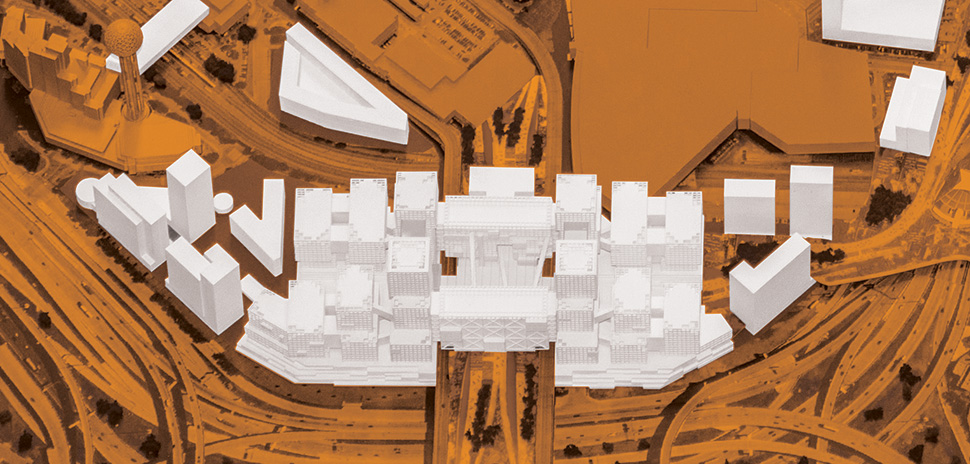
[Image: via The Real Estate Review]
MCMAHON: We also showed them what it looks like from up high in Reunion Tower, looking down on the trolley coming up from North Oak Cliff to downtown. That perspective is amazing, and they saw where the buildings could be built. And when we were back at ground level in the Cedars, looking towards downtown, it was a magical moment. Amazon could visualize the connection with high-speed rail, the connection with the Reunion Tower site, and City Hall.
Of course, we had to make sure they had some good barbecue. We had Pecan Lodge catered into a small business in Deep Ellum: Unruh Furniture, a for-profit furniture-building business with a nonprofit heart.
Kourtny Garrett did a phenomenal job making a presentation about downtown Dallas. Amazon was impressed with the Downtown 360 study and wanted copies of those studies that we’ve been engaged in executing.
Amazon wanted to talk about our challenges in Dallas. They didn’t want us to talk just about our big, beautiful, glossy city: They wanted to know where they could dig in. It was an opportunity for us to be able to tell the story of the challenges the city of Dallas has and how we’re tackling them. And how the business community is very, very involved in that. Dallas is a great place to do business. And, like any city, we have our challenges. We said, “There’s a place here to be able to help us,” and that was a part of the discussion. It was very important for them.
I wasn’t a part of the end-of-day discussion, but Mayor Rawlings and the city manager met with Amazon on the nitty gritty of the issues. I think after that, they said, “We appreciate you being honest with us.”
ROSA: Quite frankly, it was one of the best site visits I’ve ever observed and been a part of. It felt genuine. With all the questions and considerations, we had the impression that we were a serious contender for HQ2.
WATSON: One other interesting thing we learned that morning: Amazon had stipulated in their RFP their development timeline. In that meeting, they shared with us that they were compressing their timeframe by a third, maybe more.
“Dallas is a great place to do business. And, like any city, we have our challenges. We said, “There’s a place here to be able to help us,” and that was a part of the discussion. It was very important for them.”
—LINDA MCMAHON
ROSA: Dramatically compressing. We had all read 15 to 17 years to get to the 50,000 tech jobs [in the RFP]. In August 2018, we learned Amazon’s own expectations for growth and needs advanced.
We are able to easily pull talent from Texas and all the universities in South Central U.S. In Dallas-Fort Worth, we believe, absolutely, that we can satisfy 50,000 tech jobs—assuming they were all tech jobs. And they weren’t going to be all tech jobs, but we can satisfy that; we can build around that.
When that timeline gets changed to 50,000 in five years or seven years, it puts stress on every region in the country.
I think Amazon realized they were learning this whole time. In September 2017, they didn’t have all variables. They didn’t have everything nailed down. They were learning as they were going along, visiting all the places, and impacting the vision of what they could do.
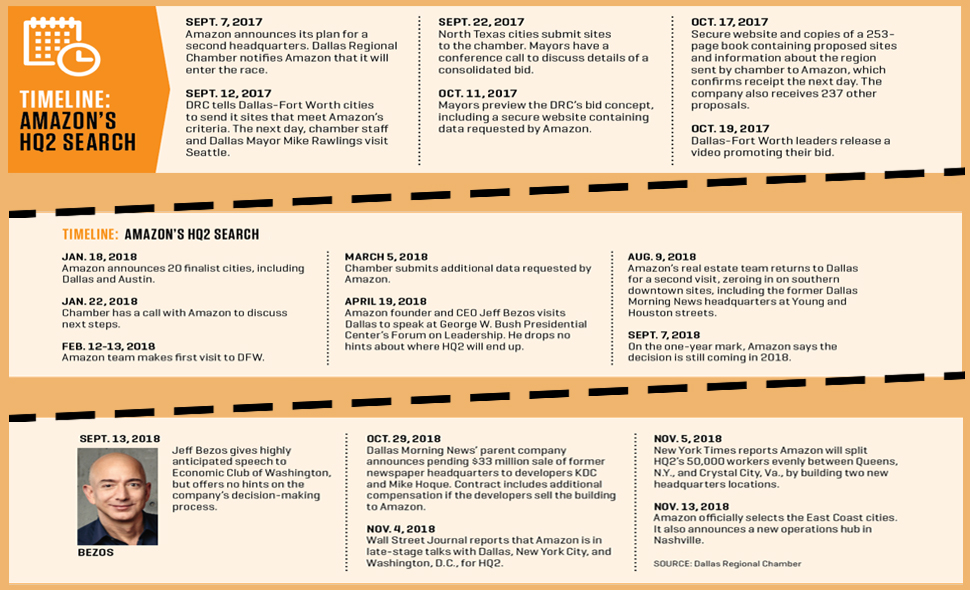
Click on the timeline for a closer look at the details of Amazon’s HQ2 search. [Source: Dallas Regional Chamber]
Ultimately, Amazon decided it was a talent issue, which we share publicly, and they shared that privately with me in a follow up phone call when we learned we weren’t going to get HQ2. It’s hard to argue the Washington, D.C., to Boston corridor, as the place that they can get the most talent, the fastest. In that corridor they were able to cast the widest talent net. [But] they’re paying more: I noticed a $150,000 average salary, when the original RFP suggested about $100,000 for a job. So they do realize there’s a price to be paid for that talent, but it superseded all other considerations.
When Amazon compressed the time schedule, it was the driving force to the ultimate outcome.
Let’s talk about that outcome.
ROSA: I talked to Holly (Sullivan) afterwards. She said we were a proven market. They loved everything about it. But talent drove them to make that decision. It was a short and sweet phone call: talent, talent, talent. Of course, I was able to understand that. They did compress that timeline. But, we did check all the boxes. Dallas-Fort Worth is the largest metropolitan area in the country that’s business friendly.
By the way, New York, Chicago, and LA are larger population numbers—larger in demographic numbers and talent numbers. But they come wrapped in a less business friendly environment. Texas is different, and Dallas-Fort Worth is different. So as we said, we knew we checked all the boxes. I’m terrifically proud of the effort. I don’t know if I would have gone back on anything. If there are golfers in the room, it’s like we went out and shot a 64 on Sunday. And we, that’s everybody: The Mayor, these individuals, everybody who worked on that 64 on Sunday. But in the end, talent was the overarching issue and Amazon’s belief that they had to find it now.
Let’s talk about the biggest lessons we’ve learned from this process and the takeaways for Dallas, going forward.
ROSA: I think it certainly raised our profile. And I think there were some companies that were waiting to see what Amazon had in mind—although those companies might not come right out and say it. Some of them probably weren’t waiting on it, but timing just happened to make it appear that way.
You’ve noticed that after Amazon made its announcement, Apple announced its expansions to its existing locations—Austin being one of those. Early in the Amazon window, in early 2018, Apple’s CEO Tim Cook said, ‘Apple’s going to grow, and grow in a couple of ways: We’re going to expand our existing locations, and we’re going to find a third place to go that’s not Texas, and not California, to build a new place [to] attract talent.’ And they came out with their Austin expansion announcement. Google did the same.
But, the largest Fortune company in 2018 to make a headquarters announcement wasn’t Amazon. It was the one that came here, to Irving. McKesson is the sixth largest company in the country. This region now has three of the Fortune 10 headquartered here. No other place in the country has more than one. New York, LA, and Chicago don’t have any. We’ve got AT&T, McKesson, and Exxon.
I’ve had a chance to see our regional cooperation in practice while working on Toyota and some of the other deals. I knew that the region would pull together and work together. That might be a surprise to some who aren’t part of this process on a regular basis. What I really learned about were the fantastic sites and the land. That bodes well for future pursuits, in not only Dallas and downtown Dallas, but all the cities in the region.
“But, the largest Fortune company in 2018 to make a headquarters announcement wasn’t Amazon. It was the one that came here, to Irving. McKesson is the sixth largest company in the country. This region now has three of the Fortune 10 headquartered here. No other place in the country has more than one. New York, LA, and Chicago don’t have any. We’ve got AT&T, McKesson, and Exxon.”
—MIKE ROSA
MCMAHON: It’s amazing what we have to offer any company in the world. The information that was pulled together by the DRC in the pitch—all the data points, all the information about access, accessibility, infrastructure—all that information was put together in one place.
I know it’s not public, but the book of information that was provided is really a phenomenal sales tool that we can use over and over again.
The spirit of cooperation between Dallas and Fort Worth, Dallas and the region, and within the development community was epic. It was incredible to see how everyone didn’t care which site was chosen—because we all win.
WATSON: I’ll echo the sentiment. The Dallas real estate communities are intensely competitive, but it was intensely collaborative on this effort. And that was a lot of fun. What was new for me was working closely with Mike Rawlings. In the last 10 days, he was ‘directing traffic’ on Saturday mornings for three groups and a handful of consultants. That was pretty fun to be a part of. He was a cheerleader for everybody around the table, and did a magnanimous job.
Where do we go from here, in terms of the impact you think that it has had—and will have—on the region? Also, what’s the relocation pipeline looking like?
ROSA: The pipeline is strong. We’ve taken the point about the great data and information that was constructed. We’ve taken that many times and broken it down, and reassembled it to meet the needs of other clients and prospects who are interested in the market. Just last night we had a dinner with a corporate headquarters opportunity for the region. We are as busy as we’ve been.
Every day that goes by, every month that goes by, more companies that we work with as a regional chamber are really keying in on where young people like to live: “Where’s the action? Where’s the fun? Where can we find the talent that we need?”
The core of the region—the downtown Dallas core—just continues to elevate. We’ve got a thriving urban core—the largest urban core in the region. It’s doing very, very well and always on the rise. There’s a desire of companies to check it out to see if that might be the place for them. And we have tremendous suburban locations and tremendous cities throughout the region—large and small. It’s a neat balance to have.
The companies that are coming in and looking, the companies making a location decision—they’re looking to the future. We know it’s a huge decision for them to make. It’s hard enough for me to think about moving my household, much less an executive moving an entire corporation and all the people they are responsible for. It’s a big disruptive thing to do. They’ve got to be sure, and they want to be in a place that they see is rising. For example, I remember working with Hilti’s North America President and CEO Cary Evert. Hilti made a decision a couple of years ago to relocate from Tulsa: They’re in Plano now. Ed note: Hilti North America President and CEO Cary Evert retired in 2017, and Hilti Canada General Manager, Avi Kahn was named President and CEO.
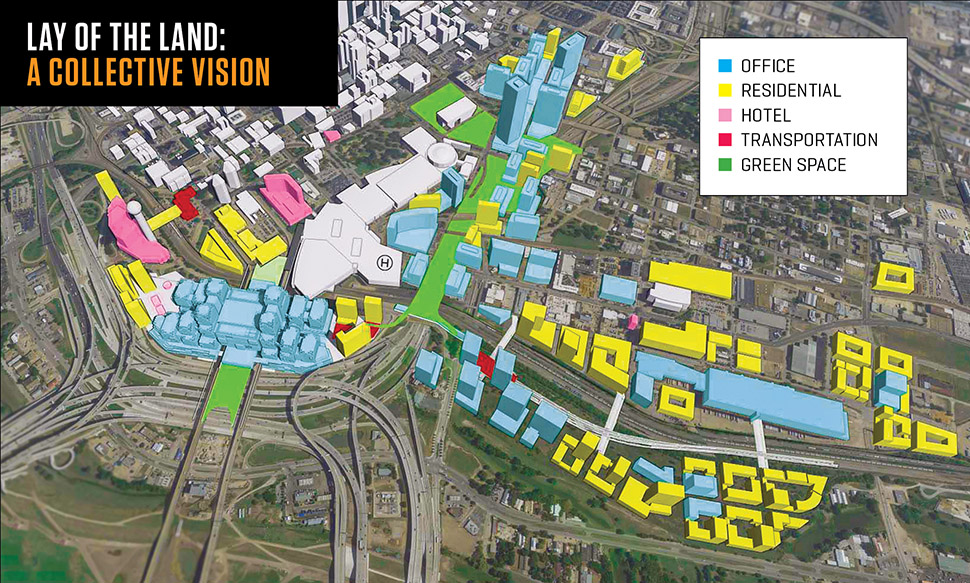
[Rendering: HKS]
The folks in Europe and the home office considered Chicago and DFW. They were more familiar with Chicago, and Dallas-Fort Worth was more of a mystery to them. They said, in the end, [they could have] made a go of it just fine in Chicago, but DFW was a place that was moving—on the rise. They’re a company that was doing that, too. It felt like a nice match for them.
We do very, very well when we’re talking with companies that have the same kind of vision that we see here: Moving forward and continuous improvement. We will be busy.
MCMAHON: Adjacency is so important. That’s the other part of the equation: Big companies come here, and they bring a lot of their suppliers and vendors with them. That’s an important part of the process. It’s exciting to see what our future is here, particularly as we can grow not only the larger corporate locations, but also the small business and middle market companies coming here as well. That’s some of the strongest space we can build for our economy and for our city.
“The core of the region—the downtown Dallas core—just continues to elevate. We’ve got a thriving urban core—the largest urban core in the region. It’s doing very, very well and always on the rise.”
—MIKE ROSA
ROSA: In terms of corporate recruitment and economic development, we will be successful. We will look back 20 years from now, 30 years from now, and we will have been successful if we are a place people want to be.
And it’s not so much people like me. I’m in my late 50s, and it’s not so much what my taste and my preferences are. It’s more about my kids and my grandkids. If Dallas-Fort Worth is the kind of place they want it to be, then companies will follow that. We’ll look back and say, “Oh, it was really that simple: Are we a place that people want to be?”
Years and years ago, economic development was pretty simple: ‘There’s a river, there’s a mountain with some iron ore in it. I guess we better put a plant right there.’
These days, with technology, there’s a lot of location freedom for companies and for individuals—especially for those that have talent. They carry that talent with them and live where they want and ply their trade where they want. More than ever before it’s about, ‘Do I want to be there?’
The answer for this city and this region has to be, ‘Yes, it’s the place that people want to be.’
It’s that simple when you boil it down.
This article was originally published in the Spring 2019 edition of the Dallas-Fort Worth Real Estate Review. The transcript has been edited for brevity and clarity.
Read the digital edition of Dallas Innovates’ sister publication, the Real Estate Review, on Issuu. Sign up for the digital alert here.
![]()
Get on the list.
Dallas Innovates, every day.
Sign up to keep your eye on what’s new and next in Dallas-Fort Worth, every day.










